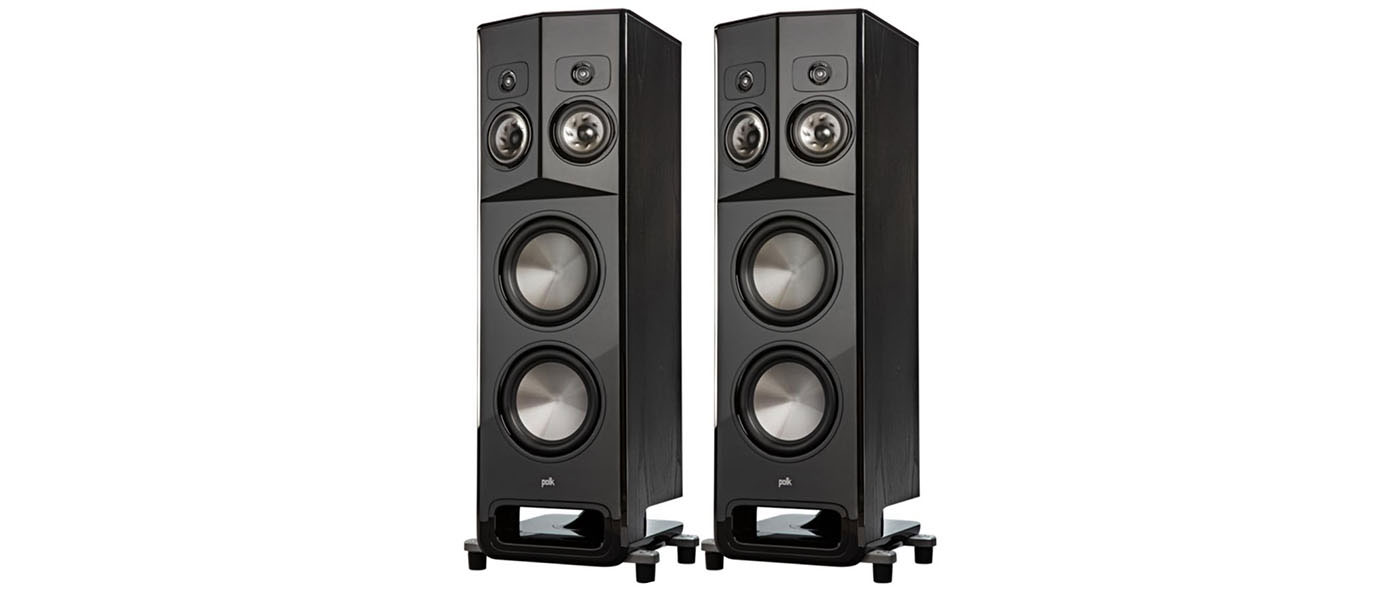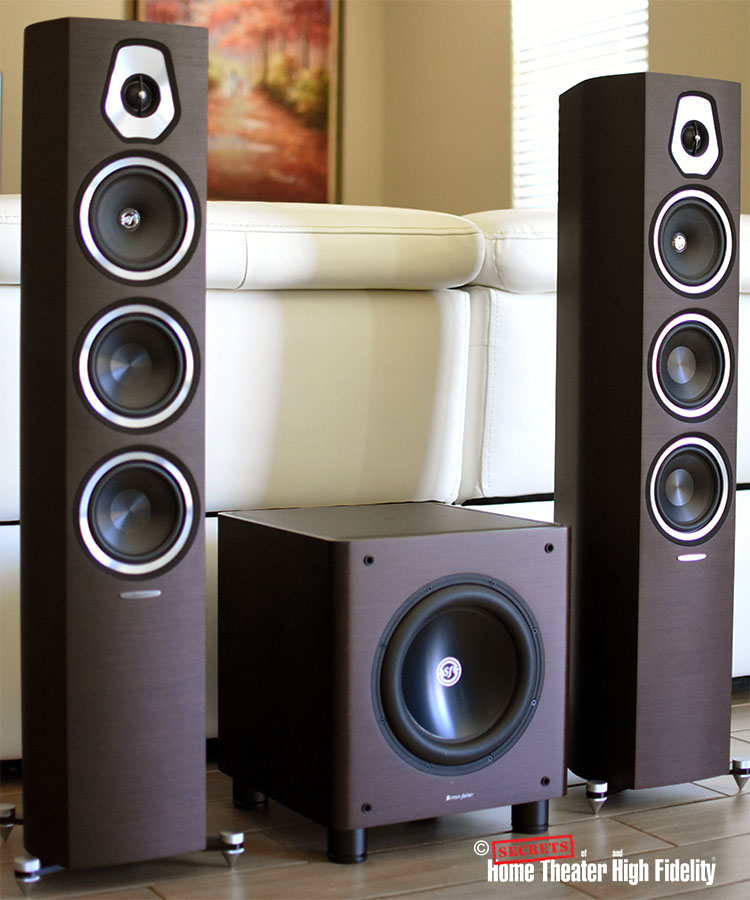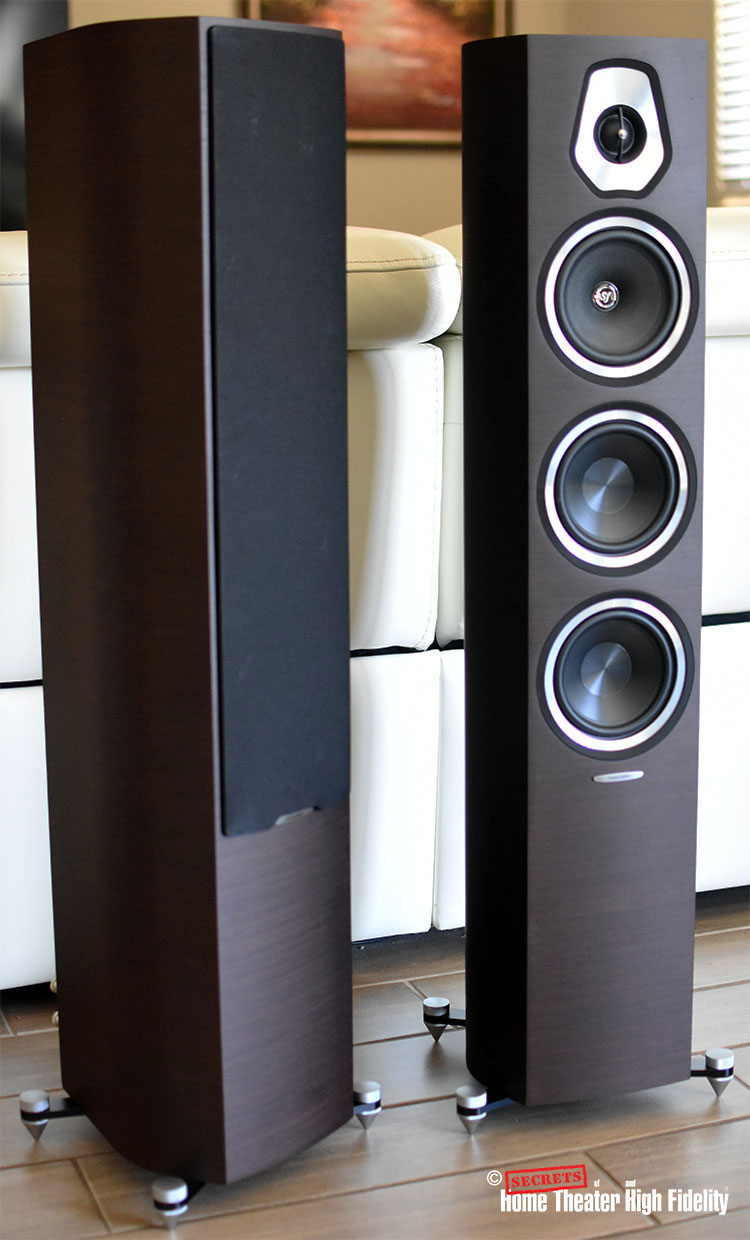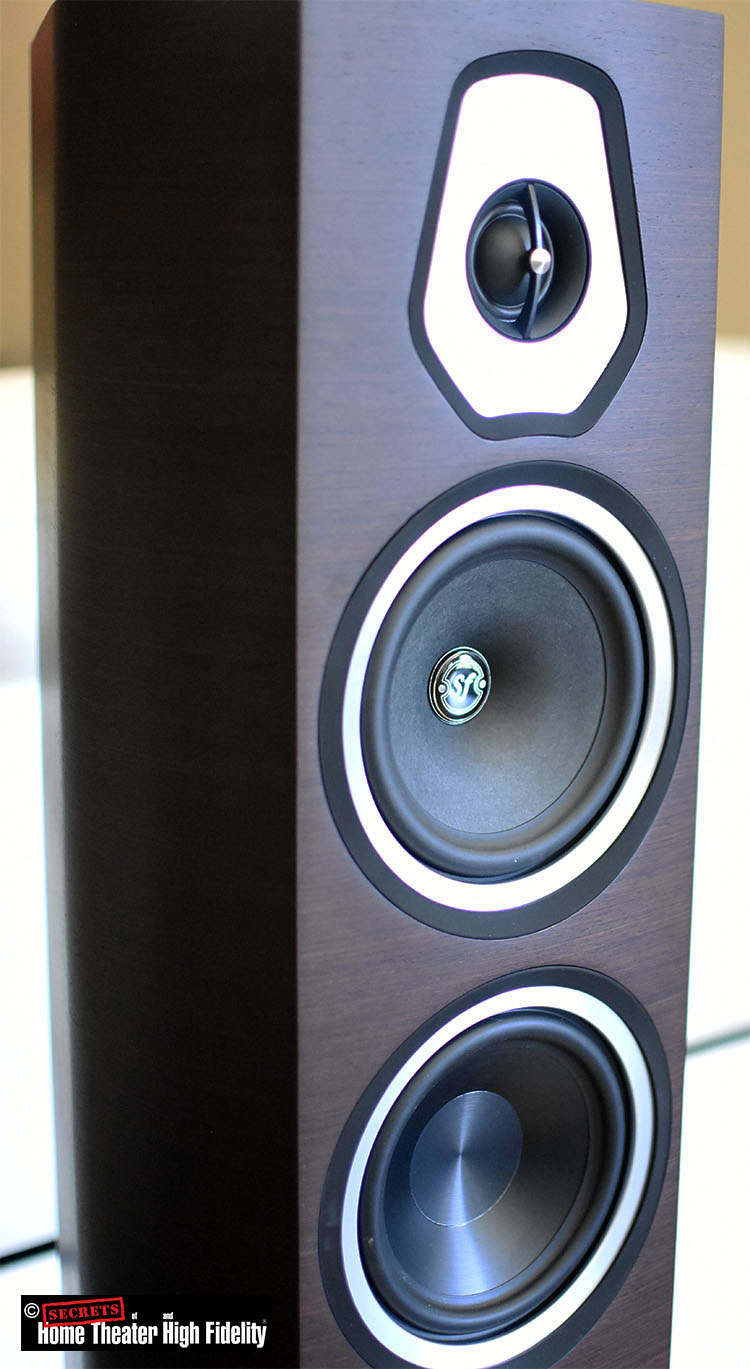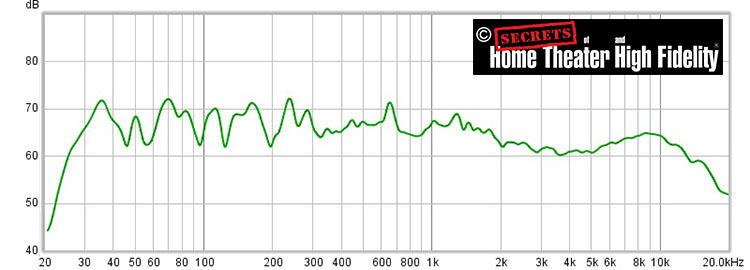
Sonus faber Sonetto III Speakers with Gravis II Subwoofer
- High-quality speaker components and materials.
- Excellent construction quality and finish.
- Compact-size speakers and subwoofer combination that does not take up much space.
- Their beauty is not just skin deep.
The Sonus faber products reviewed here are the Sonetto III (MSRP $3,999/pair), which is the smallest floor-standing speaker in the Sonus faber’s Sonetto collection, and the Gravis II subwoofer (MSRP $1,499 each), which is a compact subwoofer from the Gravis subwoofer collection. The quality of the construction of these speakers is exquisite. Their appearance and finish instill a pride of ownership. But appearance alone does not define what good speakers are about. My review below will elaborate more about the features and performance of this speakers-subwoofer combination.
Sonus faber has been producing wonderfully crafted, great-quality speakers since 1983. Just the very mention of the Sonus faber name creates a strong image of gallery-type speakers in my mind. It might be because of the artsy look that the Sonus faber speakers always have. Or, perhaps, the unique use of leather as part of the finish with their speaker cabinets. The company’s mission is not only to produce good-sounding speakers but also to impart an artistic work into their design. Sonus faber treats its speakers not just as engineering products but more so as works of art.
Sonus faber produces speakers across wide price ranges, from the relatively inexpensive Lumina collection to their ultra-expensive Reference collection. The Sonetto III speakers reviewed here are from the Sonetto collection, which sits right above the Lumina collection in the Sonus faber product lineup. At $3,999/pair, the Sonetto III is the smallest floor-standing speaker in the Sonetto collection. The review pair has the so-called wengé finish which is beautiful to look at. The review package also includes a powered subwoofer from the Sonus faber’s Gravis collection, the Gravis II (MSRP $1,499 each), with a matching wengé finish.
Sonetto III speakers:
Type:
3-way floor-standing vented box design
Drivers:
Tweeter: 1.14 in (29 mm) high-definition DAD™ dome diaphragm
Midrange: 5.9 in (150 mm) diaphragm made from cellulose pulp and other natural fibers
Woofers: two of 5.9 in (150 mm) aluminum cones
Crossovers:
220Hz and 3,250Hz
Frequency response:
42 Hz – 25,000 Hz
Sensitivity:
89 dB SPL (2.83 V/1m)
Nominal impedance:
4 ohm
Suggested amplifier power output:
50W – 250W, without clipping
Dimensions (HxWxD):
40 in x 9 in x 12 in (1018 mm x 219 mm x 305 mm)
Weight:
35.2 Ib (16 kg) each
Available finishes:
walnut, white, black, wengé
Warranty:
5 years
MSRP:
$3,999/pair
Gravis II subwoofer:
Drivers:
Active driver: 1 x 10 in (260 mm) long-throw, treated paper cone
Drone cone (passive radiator): 1 x 10 in (260 mm) long-throw, treated paper cone
Amplification:
class AB amplifier, 350 W (nominal), 700 W (peak)
Frequency response:
from 25 Hz to 120 Hz (@ – 6dB)
Controls:
- Independent Master and LFE volume controls
- Continuously adjustable Crossover frequency (30 to 120 Hz), slope 24 dB/oct
- Signal phase inversion switch (0/180°)
Audio signal inputs:
- LFE (Low Frequency Effect), mono RCA plug
- LINE, mono RCA plug
- HIGH LEVEL, Neutrik 4-pole Speakon©
Power consumption:
0.5 W (Standby), 450 W (Rated power)
Dimension (HxWxD):
15.9 in x 14 in x 16 in (404 mm x 356 mm x 408 mm) including feet
Weight:
47.3 lb (21.5 kg)
Available finishes:
walnut, white, black, wengé
Warranty:
3 years
MSRP:
$1,499 each
Website:
Company:
SECRETS Tags:
Speaker Review 2021, Subwoofer 2021, Sonus faber, Sonetto III Speakers, Speakers, Gravis II Subwoofer, Subwoofer
As with the rest of the Sonus faber speakers, the Sonetto III possesses the elegant and classy look that even non-audiophiles would appreciate. The cabinet of the speakers has a distinctive lute (tear-drop-like) cross-section shape with a real-wood finish outer layer and hand-stitched black leather top. The curvy cabinet shape is not only just for the looks; it also minimizes the internal standing waves and reflections, which can cause unwanted distortions in the output response of the speaker. This review sample comes in a gorgeous wengé finish, but other finishes are also available (glossy white, glossy black, or walnut). The grilles of the speakers attach magnetically.

The Sonetto III employs a 3-way design using 4 drivers. Many of the technologies employed on the Sonetto III are trickled down from the company’s higher-end collections, including the 29-mm silk DADTM (Damped Apex Dome) tweeter, 150-mm custom midrange driver, 150-mm aluminum woofers (two each on each speaker), and ParacrossTM crossover technology, which places some reactive components (capacitors and inductors/coils) on the negative rail of the circuit to provide better sonic definition, making it less sensitive to radio frequency interference.
The Sonetto III enclosure is vented on the bottom. In such a design, the use of the feet with proper height is crucial to get a proper bass response from the speaker. A set of four high-quality aluminum cone feet together with four holder bars, which attach to the cabinet using two screws each, are included with each speaker. The height of the cones is adjustable to take care of the floor’s unevenness. Small metal discs are also supplied and can be used to prevent the pointy tip of the cones from damaging the floor.
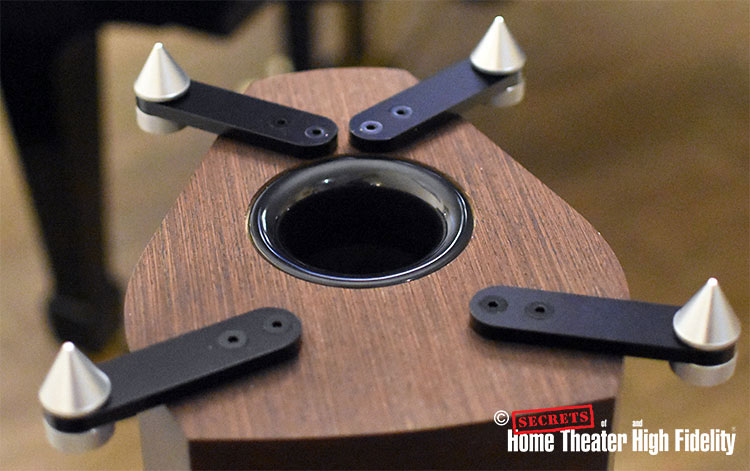
The binding posts of the Sonetto III are located on the rear panel near the bottom of the speaker. I like this low binding-post placement as it does not require running speaker cable high above the floor. Two pairs of binding posts are available for each speaker to accommodate bi-wiring/bi-amping. The speakers are shipped with metal jumpers connecting the two sets of binding posts.
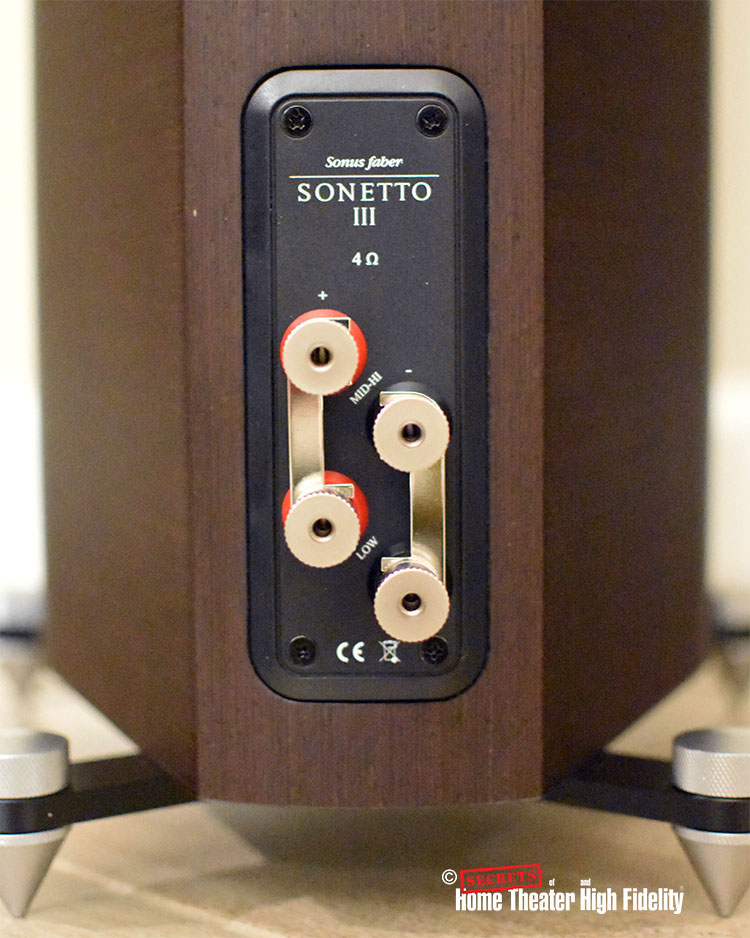
The Gravis II subwoofer, which was included in the review package, has a matching appearance like the Sonetto III speakers with the same wengé finish and black leather on top. Unlike the Sonetto speakers, the grille of the subwoofer does not have magnetic attachments, but instead, it attaches using metal pins and cups. The Gravis II is quite compact with an almost cube form factor, its longest dimension of about 16 inches. The subwoofer houses a 350 W class AB amplifier and is equipped with a single 10-inch downward-facing active driver and a 10-inch forward-facing passive radiator. Four 2-inch diameter, 2-inch tall cylindrical feet provide a stable foundation for the subwoofer. These feet also give the necessary breathing room for the optimal operation of the downward-facing driver.
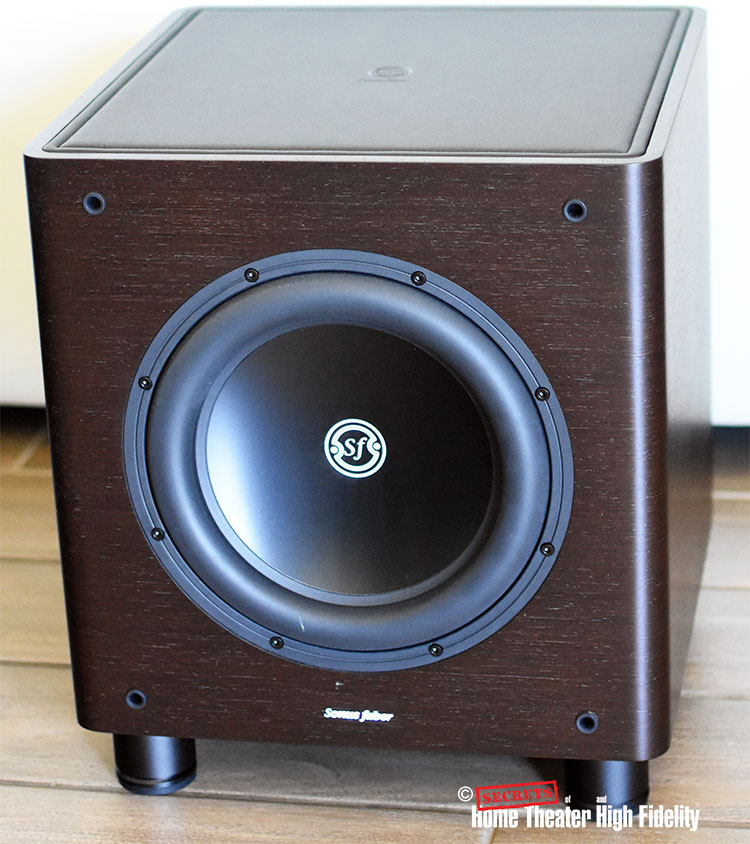
The Gravis II subwoofer has a detachable power cord and it can accept line-level input signals through single-ended RCA connectors, or speaker-level signals through a Speakon connector. There are two mono line-level input connectors, one is labeled as Line, which is functionally parallel to the speaker-level connector, and the other as LFE. The Line and LFE connectors have their own separate volume control. The LFE connection bypasses the crossover setting on the subwoofer and lets the connected processor or receiver manage this setting. I like the provision of separate volume controls for the Line and LFE applications, allowing the Gravis II to handle different bass volume settings in dual-purpose stereo/home-theater applications. The volume level that one uses for stereo music application does not have to be changed to accommodate the LFE volume setting of the home-theater application and vice versa. Besides the volume controls, the rear panel also sports the main power switch, crossover setting-knob, auto/always-on switch, and phase switch (0o or 180o). The -6 dB low-frequency extension of the subwoofer is specified at 25 Hz. The upper limit of the frequency range can reach 120 Hz, so it should be fine for complementing most bookshelf and small tower speakers.
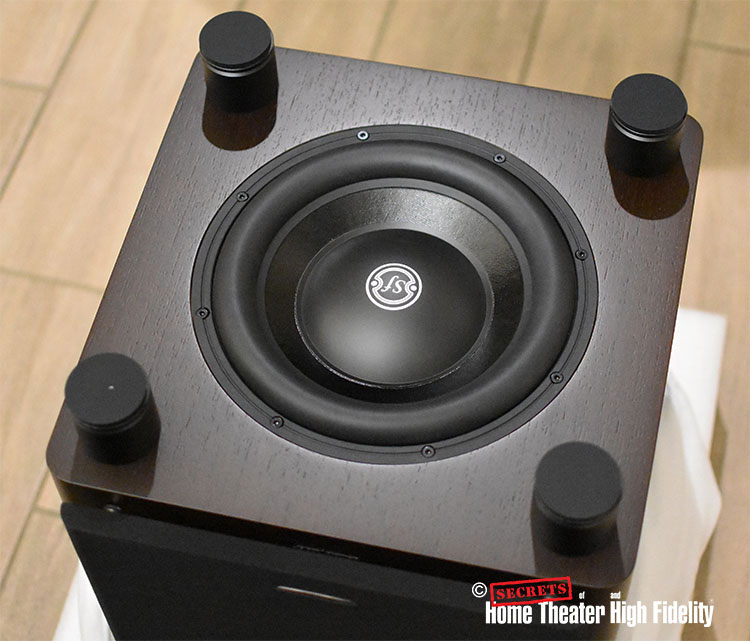
There is no DSP or wireless control feature included in the Gravis II subwoofer. This means that if good bass responses cannot be achieved after exhausting its basic controls at a particular position in the room, one should resort to trying different placements for the subwoofer. Fortunately, the Gravis II is not a big subwoofer, hence moving it around is not too much of an inconvenience.
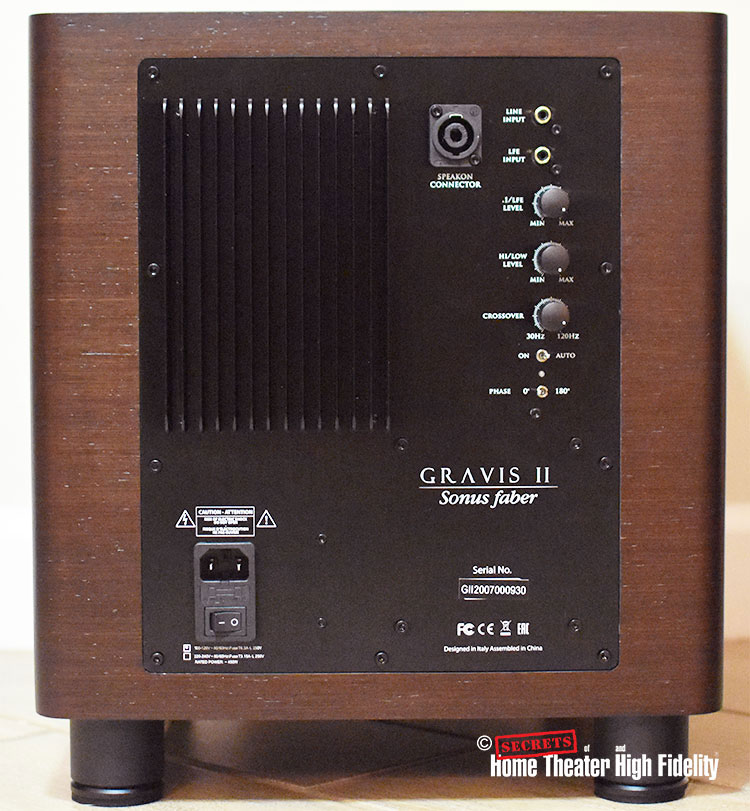
During the review, the Sonetto III speakers were driven mostly using my Michi X3 integrated amplifier in mono-wiring configuration, supplying 350 W/channel to the speakers, which have a nominal impedance of 4 ohms. The sources used were the PS Audio PerfectWave Transport and the AURALiC Aries G1 streamer. The Sonetto III speakers were set up at about 8 ft apart from each other. The front baffles of the speakers were 4 ft away from the wall behind them and slightly more than 4 ft away from the side walls. My listening position was at the same distance to each of the speakers at about 9.5 ft away from their front baffles. A slight toe-in was applied to the speakers to get the best image and soundstage in stereo playback.
The Gravis II subwoofer was tested for dual-purpose use. The line input of the Gravis II subwoofer was connected to one of the mono subwoofer outputs of the Michi X3, and the LFE input was connected to one of the LFE subwoofer outputs of my Marantz AV8802 surround processor in a home-theater application. This connection configuration allowed me to assess the performance of the subwoofer for both stereo and home-theater use. I tried various placements for the Gravis II subwoofer before finally settling in on the position that gave me the smoothest bass response, which was near the front right corner of the room outside of the plane of the Sonetto III speakers. The Gravis II subwoofer does not have wireless or remote-control features, so I had to get up from my seat a few times to adjust the volume, crossover, and phase until its response properly blended in with the Sonetto III’s. For the LFE application, the setup was much easier. I just put the LFE volume setting in the middle and let my Marantz AV8802 handle the subwoofer adjustments during the Audyssey auto-calibration process.
At the beginning of my evaluation, I listened to the Sonetto III speakers in stereo configuration without the use of a subwoofer. Most of my listening was done with the grilles off as I found that the grilles of these speakers were not very transparent and slightly muddied up the overall sonic presentation. Although the speakers exhibited relatively neutral balance across the audible frequency spectrum, the midrange stood out as their strong point. The clarity and naturality of the midrange presentation were exemplary. However, this does not mean that the Sonetto III speakers were weak on the other frequency bands. In fact, the bass was respectable for such a small tower and the treble was airy with a great depiction of details. A quick on-axis close-miked frequency-response measurement using REW software and calibration microphone, which is shown in the figure below, somewhat supports these observations. The midrange frequency response is remarkably flat (within ±1 dB), flanked by slight response dips around the crossover frequencies. These slight dips in the lower treble and upper bass region were nothing to worry about as they did not cause audible holes in the speakers’ responses. In my relatively large open room, the speakers generated useful bass extension down to about 50 Hz or so.
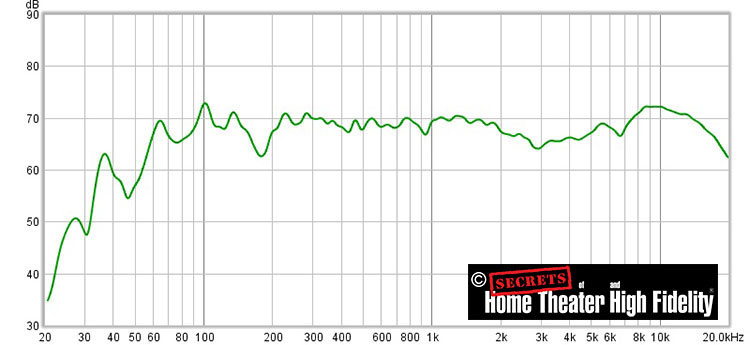
Besides the strong midrange, another sonic trait of the speakers that immediately caught my attention was their effortless imaging capability. With proper placement and positioning, the sonic images painted by the speakers were steady and sharp. I was particularly amazed by the speakers’ uncanny ability to disappear and use the space around them as a musical canvas to portray a three-dimensional soundstage.
The title track Black Moonlight from Linda Carone’s Black Moonlight album (2017) really showcased the strong imaging ability of the Sonetto III. The sound of the instruments at the opening of the track seemed to float steadily from the space behind the speakers. This sound seemed to completely detach from the speakers, appearing from various locations in the portrayed musical soundstage. Linda Carone’s jazzy voice sounded natural and was presented in such a sharp focus in the middle but slightly behind the two speakers. The speakers’ overall tonal characteristics were neither warm nor bright. They were squarely neutral with a great deal of transparency.

Linda Carone’s “Black Moonlight (2017)”
On the track, Bad Blood from the album In Defense of My Own Happiness (vol. 1) by Joy Oladokun, the portrayal of the soundstage width went far beyond the left and right speaker boundaries. The sound of the main guitar, for example, seemed to come from far to the left of the left speaker. I also heard the second guitar sound coming from the far right, outside of where the right speaker was located. Really impressive!

Jay Oladokun’s “In Defense of My Own Happiness (vol. 1) (2020)”
For a relatively small floor-stander, the Sonetto III put out a good amount of bass that is sufficiently punchy. However, some tracks, such as Mandy Moore’s Forgiveness from her Silver Landings (2020) album, really exposed the speaker’s lack of bass extension. I do think that a compliment from a subwoofer is needed to get a full-range frequency-spectrum enjoyment from the speakers. Enter the Gravis II, which was included as part of the review package.
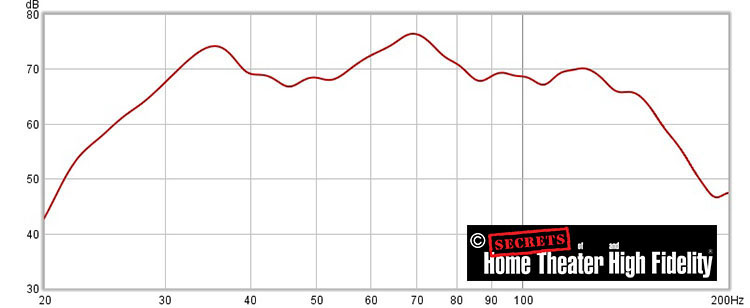
The close-miked in-room response of the Gravis II subwoofer shown above confirmed its specified frequency response with -6 dB points at 25 Hz and 120 Hz. For my setup, I obtained the smoothest blend with the Sonetto III response when the Gravis II crossover was set at 60 Hz. Once properly dialed in, the Sonetto III and Gravis II combo sounded full range for most program material. The Gravis II might not have the bass extension down to the 20-Hz range, but it was able to generate enough bass pressure in my relatively large room single-handedly. The bass coming from the Gravis II sounded articulate, tight, and punchy even when listened to at low volume. It added the necessary bass weight to the music without adding boominess. The Gravis II produced the kind of bass that could be cranked up without muddying the upper-frequency ranges. With its excellent articulation and tautness, there was no denying that the Gravis II was a remarkably competent musical subwoofer. The bass from the Gravis II was so delicious, it was somewhat addictive.

Christina Aguilera’s “Loyal Brave True (2020)”
The Gravis II brought extra motivation for me to relisten to my favorite music tracks with good amounts of bass content. And it did not disappoint, indulging me with its articulate bass foundation. I had a vastly different impression listening to the track Loyal Brave True by Christina Aguilera from Disney’s (2020) soundtrack through the Sonetto III speakers with and without the subwoofer.
While the track still came out nicely when listened without the subwoofer, the addition of the Gravis II really brought my appreciation of the track to another level. The soundstage seemed to expand more and the bass from the big drums underlying the music, which was presented with authority by the Gravis II, really made the overall score more majestic.
While the Gravis II subwoofer is at home for music applications, it is also no slouch for home-theater applications. The Gravis II might be small, but it should have no problem in filling the bass demands for home-theater usage in small to medium size rooms. Even in my relatively large listening space, a single Gravis II handled the home-theater bass satisfactorily. It showed signs of losing composure when played at very loud levels, which was quite normal for a relatively small subwoofer like this.

The combination of the Sonus faber Sonetto III speakers and Gravis II subwoofer gives you excellent build quality, elegant finish, and strong all-around sonic performances that justify the price of admission.
- Elegant look with excellent built quality and beautiful finish
- Magnetically attached grilles (Sonetto III)
- Excellent sonic transparency and clarity (Sonetto III)
- Effortless imaging capability (Sonetto III)
- Separate volume control for line and LFE inputs (Gravis II)
- Articulate and punchy bass (Gravis II)
- More transparent grilles (Sonetto III)
- More bass adjustment and control features (Gravis II)
With the Sonetto III small tower speakers, you get not only the traditional Sonus faber distinctive and elegant look, but also a wonderful sonic performance. The Sonetto III speakers wowed me with their strong midrange performance and effortless imaging capability. The speakers’ ability to disappear into the musical soundstage was downright mesmerizing.
The Gravis II subwoofer has the Sonus faber’s DNA in the looks department and proved to be a capable bass transducer. It is a relatively small subwoofer, but the bass it produced did not reflect its size at all. Punchy and articulate are the appropriate adjectives to describe the bass characteristics of the Gravis II. It complimented the Sonetto III well, filling in the lacking lower bass region seamlessly. It is a very musical subwoofer, but it has the features and capabilities to handle home-theater duties well.
There is a lot to like in the Sonetto III speakers with the Gravis II subwoofer combination. They are not cheap, but their elegant look and high-quality finish are undeniable, and more importantly, they back those up with strong overall sonic performance.


